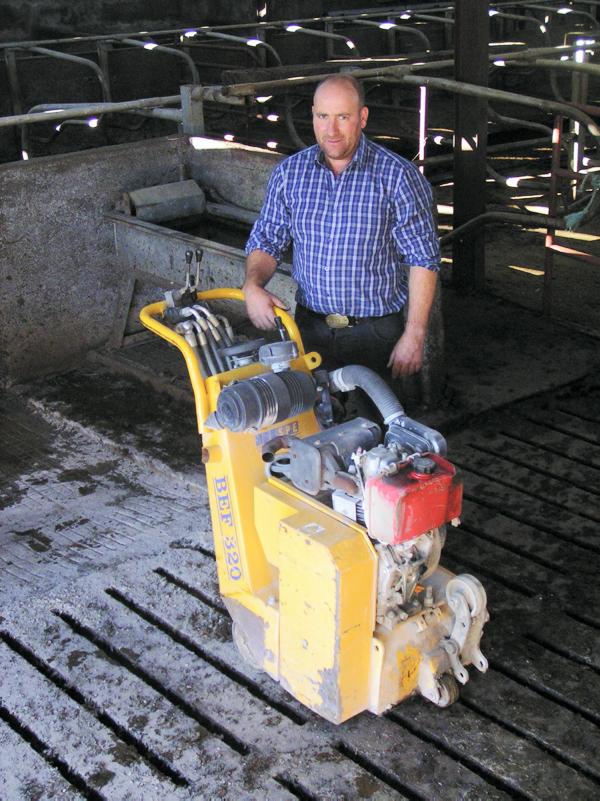Cattle’s hooves are well designed - broad enough to support their weight but sharp enough to cut into and grip moist soil. You’ll rarely see a cow or a bullock slip in a field but force them to walk across smooth wet concrete and you can see how nervous they are about slipping.
When I called to the farm at Moat View, Oldcastle in Co Meath, Andy’s son Darach was on hand to show me around.
PICTURE ONE
The first thing I asked Hugh was why more concrete is not given a good rough grip when it is being laid in the the first place. He said: "It's not really possible to do it without going to a lot of trouble and putting a rough tamp finish on concrete leaves it unlevel and that will cause bruising of cows’ feet. On the other hand, grooving with proper equipment will leave the surface smooth on top but with grooves which provide grip.’’
Hugh McCauley grooves concrete with this BEF 320 Multi Planer which he bought in Scotland. It’s a substantial machine, weighing about 300kg, and he generally brings it around in a trailer behind a van.
PICTURE TWO
This is the business end of the machine. What we’re looking at here is a heavy revolving drum on which there are four shafts carrying seven cutting wheels each.
The drum spins around at high speed – up to 1,333rpm. The wheels are diamond tipped and do the cutting. These are a wearing part and are replaced at intervals.
PICTURE THREE
Hugh was asked by Andy
Geraghty to groove this cross-over passage at the end of a row of cubicles. At housing, all the cows in the herd have to walk to and from the milking parlour via this passage. "Cows were slipping and skidding here,” Darach said.
"They were going down on their knees." Hugh begins by grooving the passage along its length. The machine is powered by its own single cylinder 10hp diesel engine. In operation it’s noisy and throws up quite a bit of dust.
PICTURE FOUR
The machine is self-driven via these small rear wheels. It wouldn’t be possible to push it around by hand. There is a small hydraulic motor at each wheel doing the driving.
Each motor is controlled by its own lever on the handle bars and this allows the machine to be steered, much in the same way that a tracked excavator is.
PICTURE FIVE
This is a castor wheel that allows for steering without having to lift the nose of the machine.
Meanwhile, the drum rotates so that dust and concrete chips are fired out the front.
PICTURE SIX
Hugh has grooved most of the passage along its length. We can see the dust and chips cut off by the cutting wheels.
Grooving in one direction would improve the grip for the cows’ feet on this smooth concrete.
PICTURE SEVEN
However, significantly more grip is obtained by now grooving the other way, across the passage, to give the criss cross finish.
"The criss cross pattern results in a floor with 40mm by 40mm sqaures and that gives the best grip by far," Hugh said. "I groove at a depth of 4mm to 5mm. As the blades wear I let the cutter roller down to compensate. It’s a high maintenance machine.”
PICTURE EIGHT
This is the finished job. The cows won’t skid and slip here now. Hugh went as close as he could to the passage walls. All the surface has been grooved in at least one direction.
PICTURE NINE
This is the front of the Geraghty’s milking parlour. Andy had this grooved soon after the parlour was constructed some years ago.
In a big open area like this, there is room for a groving machine to operate comfortably and the full surface shows a nice criss-cross pattern. Cows have a good grip here, Darach said.
PICTURE 10
"Grooving will result in less stress on the cows and big beef cattle and allow them to move around a shed with more confidence," Hugh said.
He charges €3.50 plus 13.5% VAT per square meter with a minimum charge of €300.
"The usual areas we do are passageways and holding areas, where cows are standing waiting. But we also do the sides of parlours as well. With all the washing down they get very slippy."
*This article was previously published in the Irish Farmers Journal on 27 October 2012.






 This is a subscriber-only article
This is a subscriber-only article














SHARING OPTIONS: